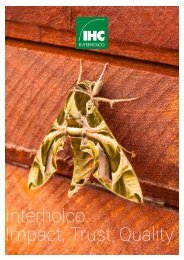Nomenclature Générale des Bois Tropicaux - 7ème édition
(english description below) Cette nomenclature est utilisée pour la mise à jour du 'Harmonized Code System' de l’Organisation Mondiale des Douanes. Dans la circulaire du 5 avril 2005, le Ministère de l’Economie, des Finances et de l’Industrie (France) reconnaît l’ATIBT comme « gardien du temple » de la nomenclature des bois tropicaux. La Commission Européenne mentionne la nomenclature de l’ATIBT comme document de référence pour la mise en œuvre du RBUE. Depuis 1954, l’ATIBT a établi et mis à jour une nomenclature des bois tropicaux faisant correspondre chaque espèce botanique avec un nom pilote reconnu internationalement. La détermination du nom pilote d’une essence est cruciale, car sa commercialisation dépend très largement de l’adoption de ce nom par le public. Le nom pilote assure la protection de l’appellation commerciale de l’essence et l’intégrité des propriétés qui lui sont attribuées, sans risque de confusion. The 1982 version of the general timber nomenclature has finally been updated as some of the 1,750 identified species, are no longer traded, while others, which were not previously included, are now on the market. The present revision has also integrated changes related to new taxonomy, in order to reflect the latest scientific developments. This Nomenclature has been used for the Harmonized Code System, updated by the World Customs Organization. The French Ministry of economy, finance and industry has given official recognition to ATIBT as the reference for the tropical timber nomenclature (NOR: PRMX0508285C of April 5th 2005). The European Commission refers to ATIBT nomenclature as a reference document for the implementation of the EUTR regulation. Since 1954, ATIBT has established and updated a nomenclature of tropical wood, linking each botanical species with an internationally recognized pilot name. A sigle wood species may have many common names; when trading across different countries, this may lead to confusion. Fixing the pilot name of a timber species is crucial, to protect the commercial denomination of the species and guarantee the veracity of the properties linked to that species, without confusion.
(english description below)
Cette nomenclature est utilisée pour la mise à jour du 'Harmonized Code System' de l’Organisation Mondiale des Douanes. Dans la circulaire du 5 avril 2005, le Ministère de l’Economie, des Finances et de l’Industrie (France) reconnaît l’ATIBT comme « gardien du temple » de la nomenclature des bois tropicaux. La Commission Européenne mentionne la nomenclature de l’ATIBT comme document de référence pour la mise en œuvre du RBUE.
Depuis 1954, l’ATIBT a établi et mis à jour une nomenclature des bois tropicaux faisant correspondre chaque espèce botanique avec un nom pilote reconnu internationalement. La détermination du nom pilote d’une essence est cruciale, car sa commercialisation dépend très largement de l’adoption de ce nom par le public. Le nom pilote assure la protection de l’appellation commerciale de l’essence et l’intégrité des propriétés qui lui sont attribuées, sans risque de confusion.
The 1982 version of the general timber nomenclature has finally been updated as some of the 1,750 identified species, are no longer traded, while others, which were not previously included, are now on the market. The present revision has also integrated changes related to new taxonomy, in order to reflect the latest scientific developments.
This Nomenclature has been used for the Harmonized Code System, updated by the World Customs Organization. The French Ministry of economy, finance and industry has given official recognition to ATIBT as the reference for the tropical timber nomenclature (NOR: PRMX0508285C of April 5th 2005). The European Commission refers to ATIBT nomenclature as a reference document for the implementation of the EUTR regulation.
Since 1954, ATIBT has established and updated a nomenclature of tropical wood, linking each botanical species with an internationally recognized pilot name. A sigle wood species may have many common names; when trading across different countries, this may lead to confusion. Fixing the pilot name of a timber species is crucial, to protect the commercial denomination of the species and guarantee the veracity of the properties linked to that species, without confusion.
You also want an ePaper? Increase the reach of your titles
YUMPU automatically turns print PDFs into web optimized ePapers that Google loves.
Liste des noms scientifiques des bois tropicaux avec renvoi au nom pilote /// 23
NOM BOTANIQUE
BOTANICAL NAME
Dialium acuminatum LI.Williams (cf. D. guianensis)
FAMILLE
FAMILY
CONTI-
NENT
Leguminosae (Caesalpiniaceae) AM Jutahy
Dialium aubrevillei Pellegr. Leguminosae (Caesalpiniaceae) AF Eyoum
Dialium bipindense Harms Leguminosae (Caesalpiniaceae) AF Eyoum
Dialium cochinchinensis Pierre Leguminosae (Caesalpiniaceae) AS Keranji
Dialium dinklagei Harms Leguminosae (Caesalpiniaceae) AF Eyoum
Dialium guianensis Sandw. Leguminosae (Caesalpiniaceae) AM Jutahy
Dialium indum L. Leguminosae (Caesalpiniaceae) AS Keranji
Dialium pachyphyllum Harms Leguminosae (Caesalpiniaceae) AF Eyoum
Dialium platysepalum Baker Leguminosae (Caesalpiniaceae) AS Keranji
Dicorynia guianensis Amsh. Leguminosae (Caesalpiniaceae) AM Basralocus
Dicorynia paraensis Benth. Leguminosae (Caesalpiniaceae) AM Basralocus
Didelotia spp. Leguminosae (Caesalpiniaceae) AF Gombé
Didelotia africana Baill. Leguminosae (Caesalpiniaceae) AF Gombé
Didelotia brevipaniculata J. Léonard Leguminosae (Caesalpiniaceae) AF Gombé
Didelotia idae Oldeman & al. Leguminosae (Caesalpiniaceae) AF Gombé
Didelotia letouzeyi Pellegr. Leguminosae (Caesalpiniaceae) AF Gombé
Didymopanax morototoni Decne. & Planch. (cf.
Schefflera morototoni)
Araliaceae AM Morototo
Dillenia spp. Dilleniaceae AS Simpoh
Dillenia aurea Sm. Dilleniaceae AS Simpoh
Dillenia excelsa Gilg Dilleniaceae AS Simpoh
Dillenia eximia Miq. Dilleniaceae AS Simpoh
Dillenia grandifolia Wall. Dilleniaceae AS Simpoh
Dillenia indica L. Dilleniaceae AS Simpoh
Dillenia ovata Wall. Dilleniaceae AS Simpoh
Dimorphandra spp. Leguminosae (Caesalpiniaceae) AM Aiéouéko
Dimorphandra hohenkerkii Sprague & Sandw.
(cf. D.polyandra)
Leguminosae (Caesalpiniaceae) AM Aiéouéko
Dimorphandra polyandra Benoist Leguminosae (Caesalpiniaceae) AM Aiéouéko
NOM PILOTE
PILOT NAME
Dinizia excelsa Ducke Leguminosae (Mimosaceae) AM Angelim vermelho
Diospyros p.p. (AF) Ebenaceae AF Ebène d’Afrique
Diospyros p.p. (Madagascar) * Ebenaceae AF Ebène de Madagascar
Diospyros p.p. (AS) Ebenaceae AS Ebène noire d’Asie
Diospyros p.p. (AS) Ebenaceae AS Ebène veinée d’Asie
Diospyros burmanica Kurz Ebenaceae AS Burmese Ebony
Diospyros celebica Bakh. Ebenaceae AS Ebène veinée d’Asie
Diospyros crassiflora Hiern Ebenaceae AF Ebène d’Afrique
Diospyros ebenum Koen. Ebenaceae AS Ebène noire d’Asie
Diospyros ferrea Willd. (cf. D.vera) * Ebenaceae AS Ebène noire d’Asie
Diospyros gracilipes Hiern * Ebenaceae AF Ebène de Madagascar
Diospyros hazomainty H.Perrier * Ebenaceae AF Ebène de Madagascar














